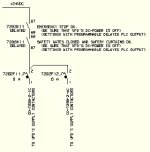thierry2003
Member
- Join Date
- Oct 2003
- Posts
- 70

I have the following problem.
When I open a door or push the emergency button a motor driven by a VFD needs to stop.
I am using a safety-relay but how do I stop the VFD? Do I cut the power to the VFD (this is what we're doing now) or do I put a contact from the safety-relay in series with the run-command of the VFD or...
I've even seen a drawing from Pilz where they cut of two contactors (done by the safety-relay)on the output of the VFD.
Anyone knows?
When I open a door or push the emergency button a motor driven by a VFD needs to stop.
I am using a safety-relay but how do I stop the VFD? Do I cut the power to the VFD (this is what we're doing now) or do I put a contact from the safety-relay in series with the run-command of the VFD or...
I've even seen a drawing from Pilz where they cut of two contactors (done by the safety-relay)on the output of the VFD.
Anyone knows?







